How to Install PostgreSQL 15 and pgAdmin in RHEL 9
Step 1: Installing PostgreSQL on RHEL 9
1. First, disable the built-in PostgreSQL module by running the following dnf command.
# dnf -qy module disable postgresql
2. Next, enable the official PostgreSQL Yum Repository as shown.
# dnf install -y https://download.postgresql.org/pub/repos/yum/reporpms/EL-9-x86_64/pgdg-redhat-repo-latest.noarch.rpm
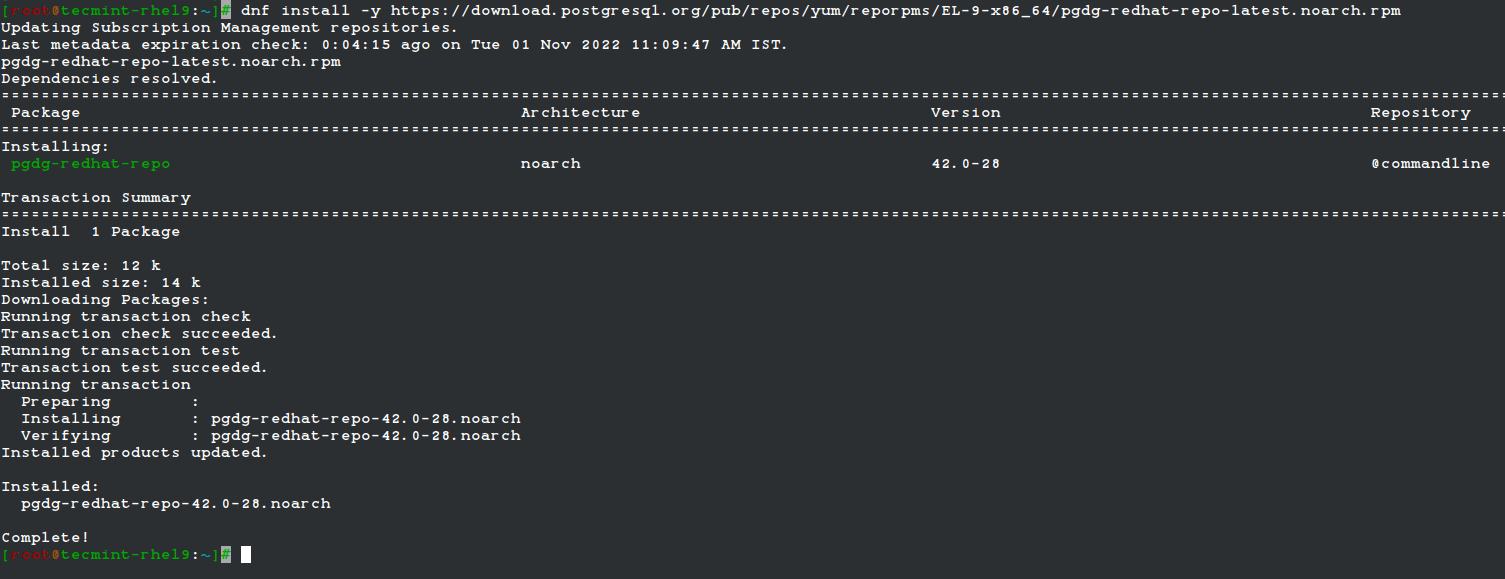
3. Next, install the PostgreSQL 15 server and client packages.
# dnf install -y postgresql15-server
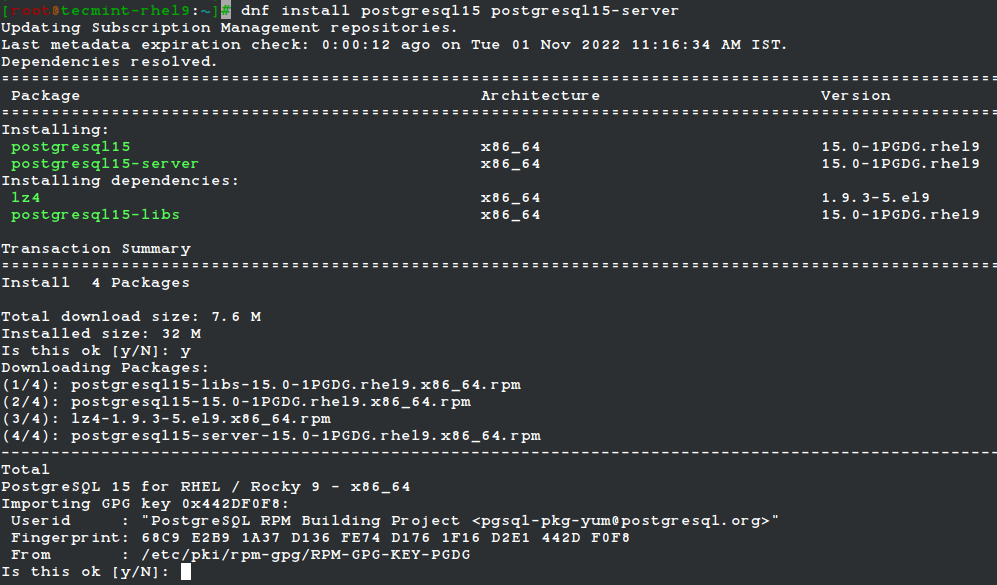
4. Once the installation is complete, initialize the PostgreSQL database, then start the PostgreSQL-15 service and enable it to automatically start at system boot. Then check if the service is up and running, and is enabled as shown.
# /usr/pgsql-15/bin/postgresql-15-setup initdb # systemctl start postgresql-15 # systemctl enable postgresql-15 # systemctl status postgresql-15 # systemctl is-enabled postgresql-15
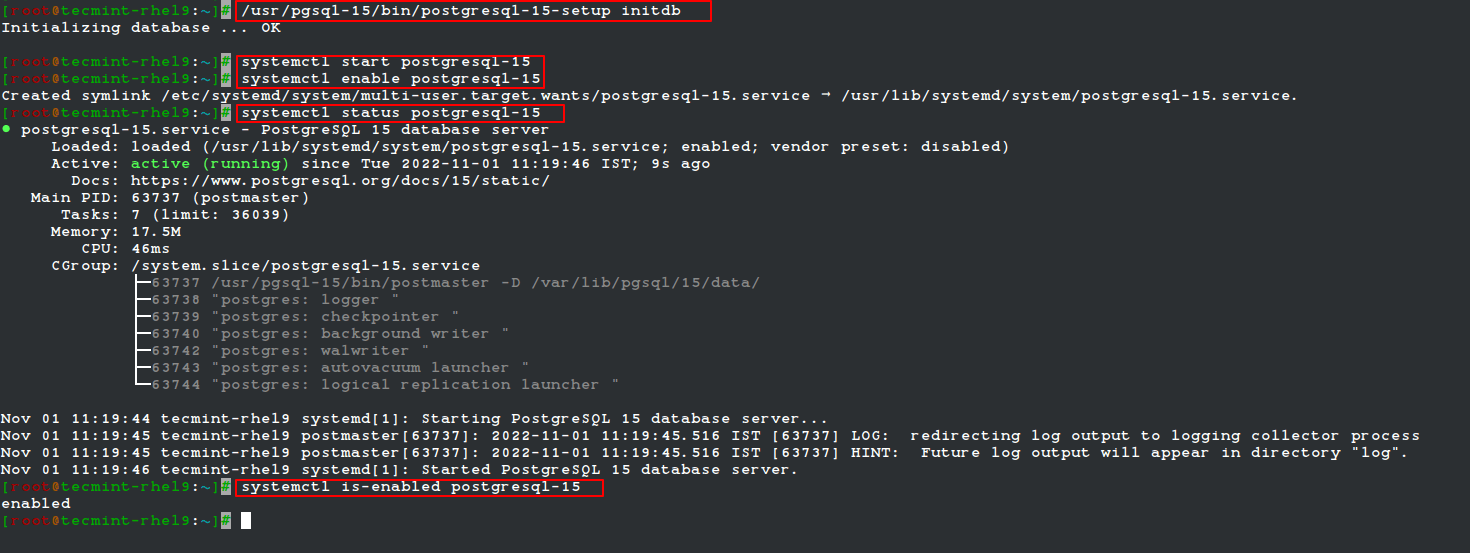
Step 2: Secure and Configure PostgreSQL Database
5. Next, secure the Postgres user account and the database administrative user account. Start by creating a password for a Postgres system user account using the passwd utility as shown.
# passwd postgres

6. Then switch to the Postgres system account and create a secure and strong password for PostgreSQL administrative database user/role as follows.
# su - postgres $ psql -c "ALTER USER postgres WITH PASSWORD 'securep@sshere';" $ exit

7. Now configure how the Postgres server will authenticate clients such as pgAdmin. The supported authentication methods include password-based authentication which uses one of these methods: md5, crypt, or password.
For this guide, we will configure the md5 authentication method in the file /var/lib/pgsql/15/data/pg_hba.conf.
# vi /var/lib/pgsql/15/data/pg_hba.conf
Find the following lines and change the authentication method to md5 as highlighted in the screenshot.
host all all 127.0.0.1/32 md5 host all all ::1/128 md5

8. After saving the file, to apply the recent changes in the Postgres configuration, restart the Postgres service.
# systemctl restart postgresql-15
Step 3: Installing pgAdmin4 in RHEL 9
9. Now we will install pgAdmin 4 to manage the PostgreSQL database from the web. First, you need to enable the EPEL and pgAdmin yum repositories which contain some of the dependencies.
# subscription-manager repos --enable codeready-builder-for-rhel-9-$(arch)-rpms # dnf install https://dl.fedoraproject.org/pub/epel/epel-release-latest-9.noarch.rpm # dnf install -y https://ftp.postgresql.org/pub/pgadmin/pgadmin4/yum/pgadmin4-redhat-repo-2-1.noarch.rpm
10. Now build a cache for newly installed pgAdmin and EPEL repositories and install pgAdmin using the following commands.
# dnf makecache # yum install pgadmin4
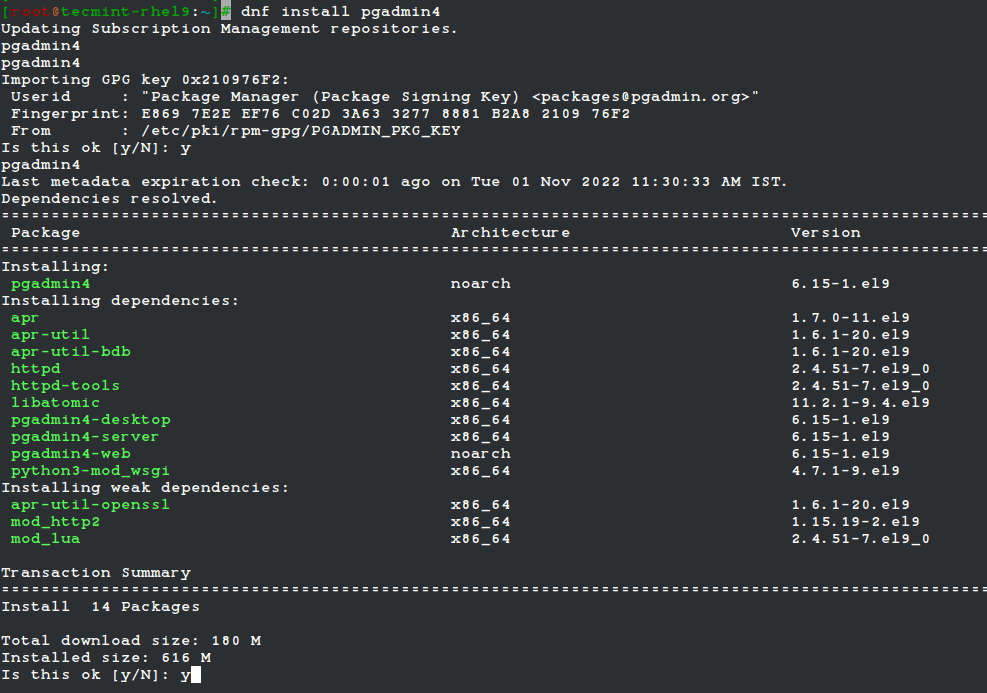
11. Next, start the httpd service and enable it to auto-start at system boot, then check if it is up and running as shown.
# systemctl start httpd # systemctl enable httpd # systemctl status httpd
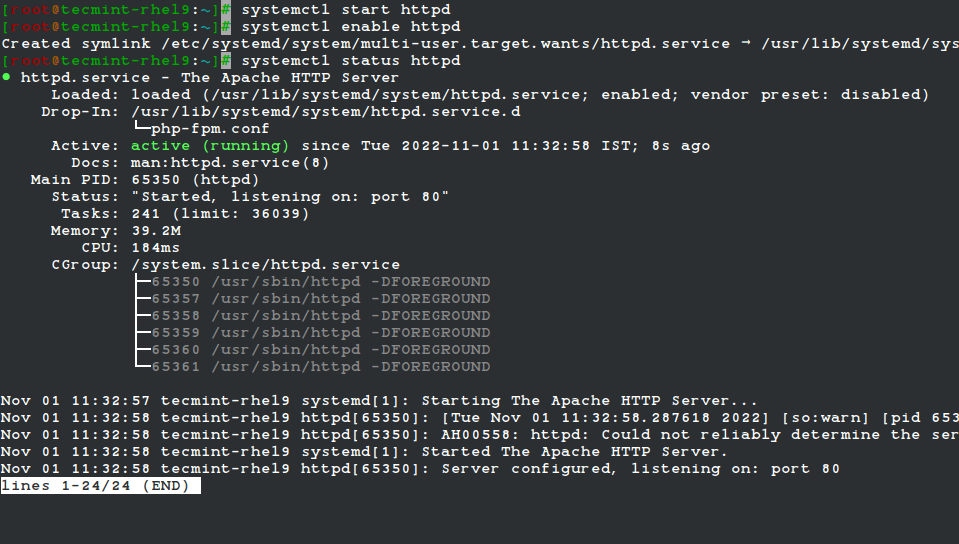
Step 4: Configuring pgAdmin 4 in RHEL 9
12. The pgadmin4 package comes with a configurable script to configure the pgAdmin web service, which will create a user account used to authenticate in the web interface, configure SELinux policies and Apache webserver to deploy pgAdmin web service.
# /usr/pgadmin4/bin/setup-web.sh
Sample Output
Setting up pgAdmin 4 in web mode on a Redhat-based platform... Creating configuration database... NOTE: Configuring authentication for SERVER mode. Enter the email address and password to use for the initial pgAdmin user account: Email address: admin@tecmint.com Password: Retype password: pgAdmin 4 - Application Initialisation ====================================== Creating storage and log directories... Configuring SELinux... The Apache web server is running and must be restarted for the pgAdmin 4 installation to complete. Continue (y/n)? y Apache successfully restarted. You can now start using pgAdmin 4 in web mode at http://127.0.0.1/pgadmin4
13. If you have the firewalld service enabled and running, open ports 80 and 443 in the firewall to allow traffic to the HTTPD web server as shown.
# firewall-cmd --permanent --zone public --add-port 80/tcp # firewall-cmd --permanent --zone public --add-port 443/tcp # firewall-cmd --reload
Step 5: Accessing pgAdmin Web Interface
14. To access the pgAdmin web interface, open a browser and navigate using the following URL.
http://SERVER_IP/pgadmin4 OR http://localhost/pgadmin4
Once the login interface loads, use the email address and password you created in step 12 above to log in.
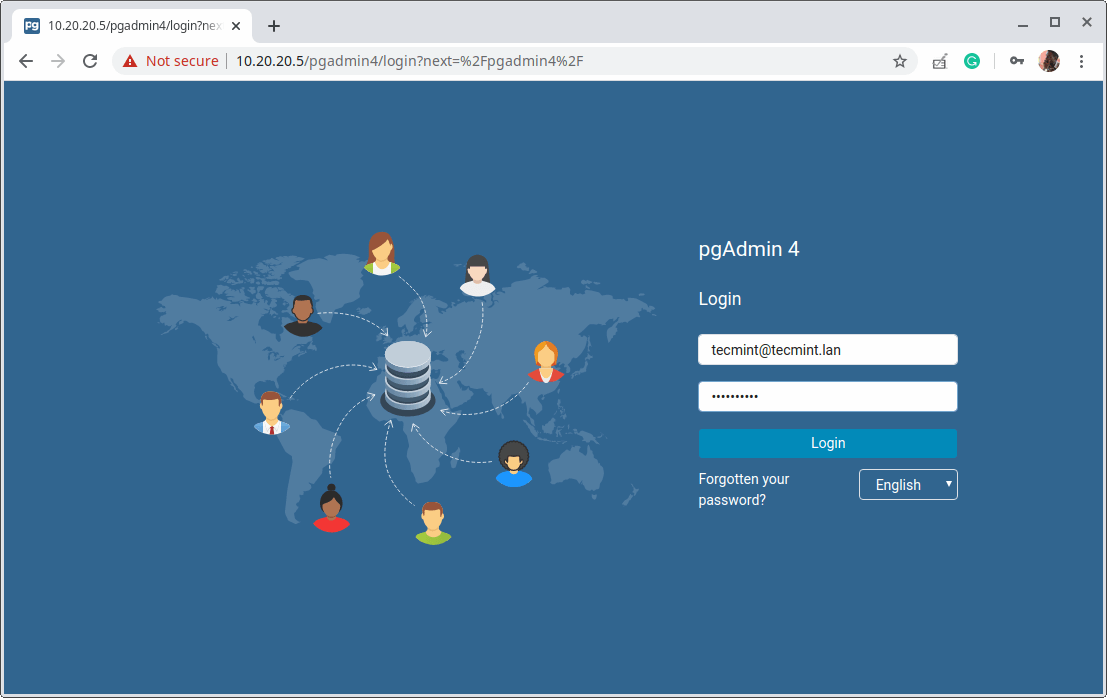
15. Next, add a new server connection by clicking on “Add New Server”.
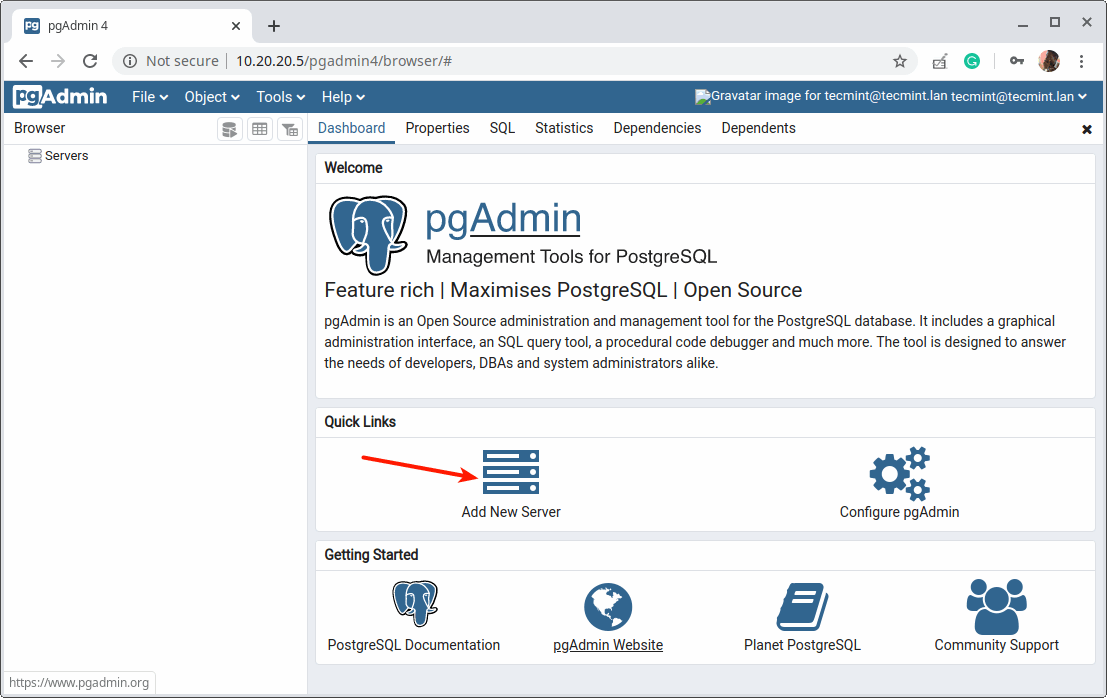
16. Then under the “General” tab, enter the following settings server Name and optionally leave a comment to describe the connection.
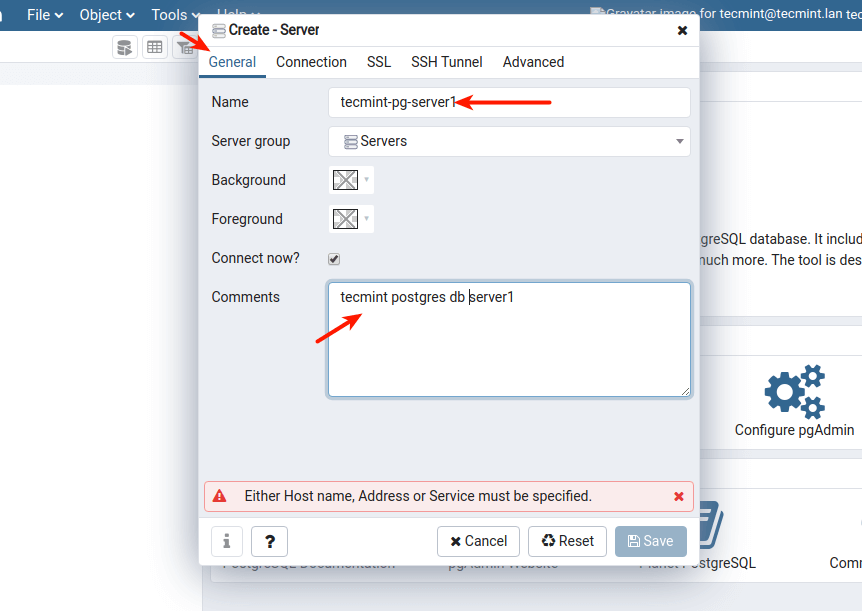
17. Then define the connection profile by filling in the following:
- Host – host/IP address of the PostgreSQL server.
- Port – defaults to 5432.
- Maintenance Database – defaults should be Postgres.
- Username – the database username. You can use Postgres.
- Password – password for the above user.
Then click Save.
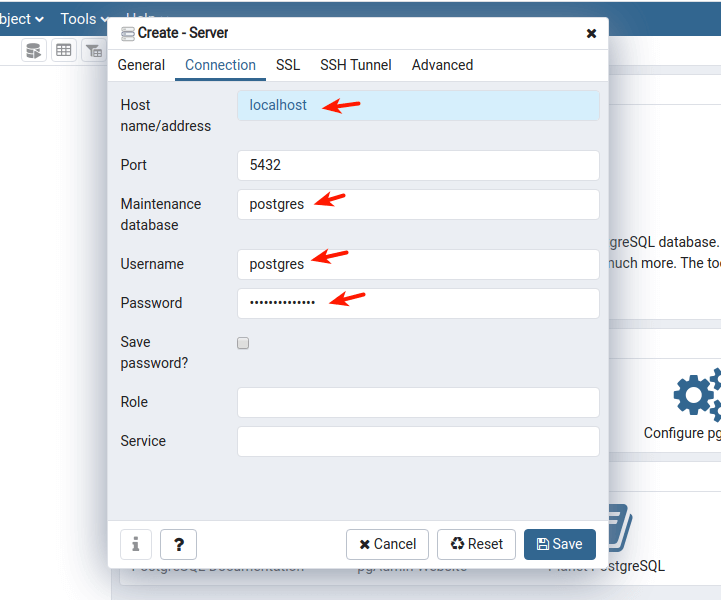
18. The new server should now appear under the list of servers as highlighted in the following screenshot.
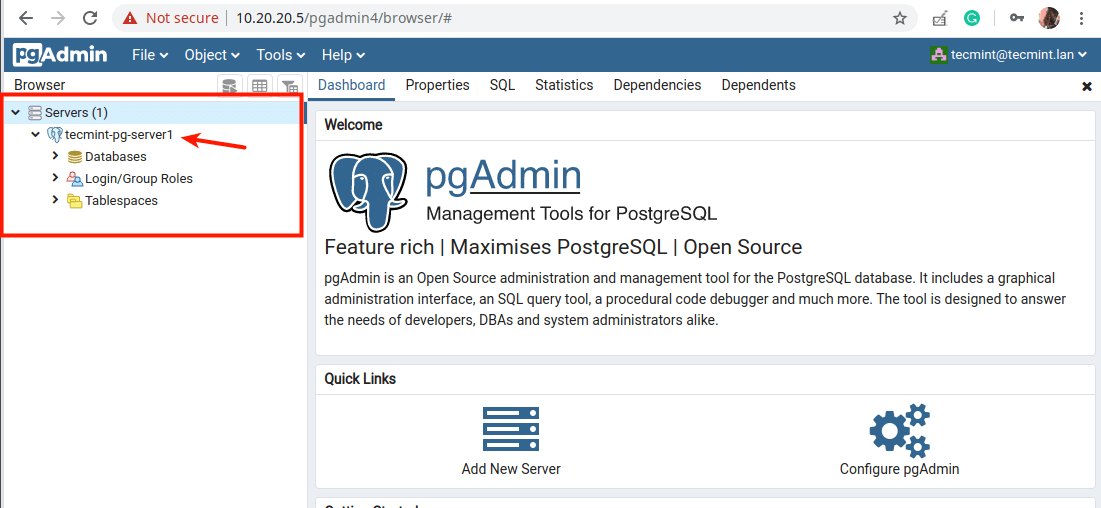
19. When you click on the server name, its attributes should load under the Dashboard as shown in the following screenshot.
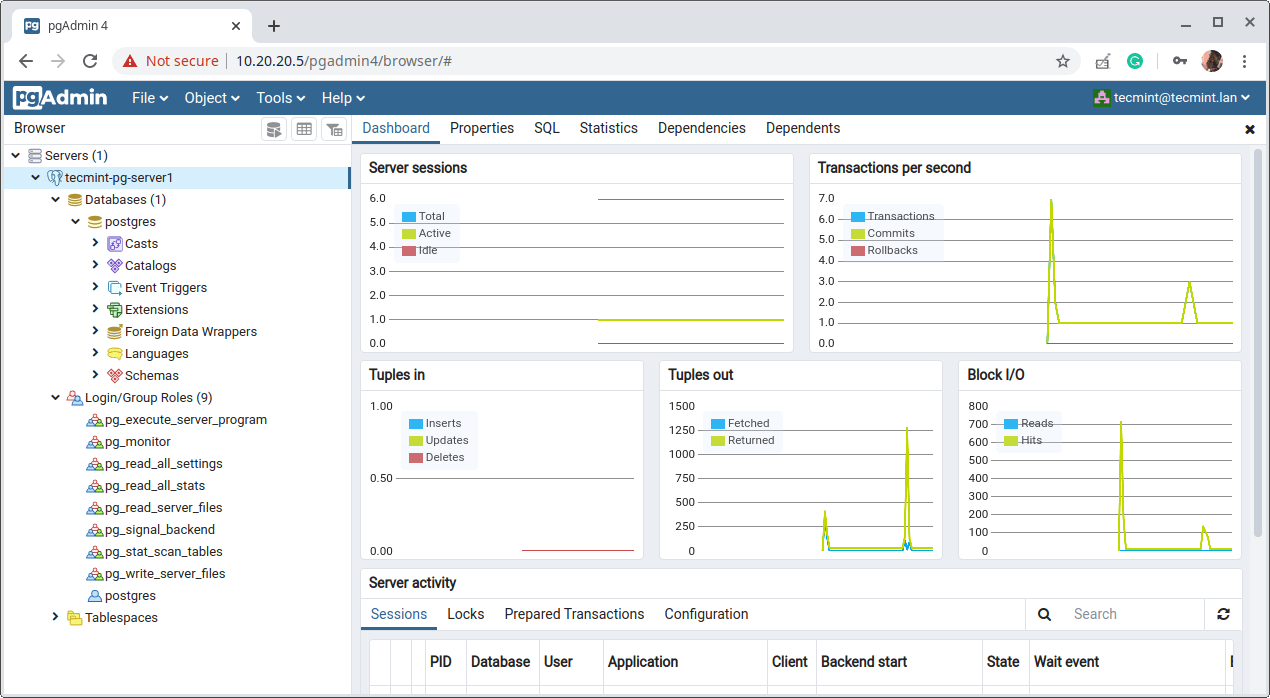
There you have it! You have successfully installed Postgresql 15 and pgAdmin 4 in RHEL 9. Reach us via the feedback form below for any thoughts and questions.
“I largely felt adjustments before I noticed any. Feeling happier, extra at ease, much less anxious,” explains
Schwartz. “And the ‘downsides’ are so insignificant compared to feeling comfortable in your body and the way you present to the world.” When I managed to break this mindset, spurts of inspiration always brought me to r/ftm.
Each time I got too far into the possibilities,
physiological panic would set in, leaving me x’ing every little thing out, feeling faint,
and chaotically texting friends. Entrenched in Lavery’s “levels,” it felt that the circumstances of my life had, for some purpose,
made that avenue totally incompatible for me.
While some may experience short-term swelling or changes in sensation after pumping
classes, there isn’t a assure for long-term outcomes or any important influence on general genital size
or function. Additionally, improper use or overuse can result
in potential health risks such as tissue harm, infections, and nerve
injury. The extent of bottom development varies from person to person, as every individual’s physique reacts
in another way to HRT. However, understanding how long do steroids
take to work (Eli) this course of works can give
trans individuals a better thought of what to anticipate and the way they can support their own bottom development.
The primary function of FTM pumping is to attain bottom development or masculinization of the genitals.
For many trans men, having a bigger and more masculine-looking
genital space can significantly enhance their self-confidence and general
sense of masculinity. It can also help alleviate gender dysphoria
– the misery skilled when one’s gender identification does not align with their assigned intercourse at birth.
After months of researching the adjustments I
would expertise on testosterone, I by no means found any point out of backside progress — progress of the clitoris.
When you are aroused or stimulated, your erectile tissue will expand,
just like it did earlier than you began utilizing T.
As you experience backside growth, your erect tissue will be extra obvious.
Some individuals could experience only minimal growth, whereas others might not expertise any noticeable
adjustments. The degree of bottom growth can vary based mostly on genetics, dosage, and particular person response to
testosterone. You may feel as if you must adjust
your junk usually, or that there’s strain, burning, itching, or
slight pain down there. It’s important to know the distinction between these sensations related
to backside growth on testosterone HRT and the symptoms of
STIs. Normally, the discomfort of bottom development will resolve itself after the primary six months of
starting HRT.
This is primarily as a result of hormonal modifications that testosterone brings about within the physique.
Testosterone stimulates the growth of erectile tissues, leading to
clitoral enlargement. In phrases of timeline, it is essential to keep in mind that backside growth is a gradual course of that occurs
over several months and even years.
And for individuals who’ve simply obtained some
more questions, learn up on testosterone within the Library.
The commonplace recommendation is that backside growth isn’t reversible as quickly as it starts.
Nevertheless, anecdotally, we have heard from people who weren’t on T for an extended time, had
been on low doses, or didn’t have a considerable quantity of
progress, that backside progress reverted utterly (or almost entirely) after stopping T.
In phrases of intercourse drive, many describe modifications in their orgasms and within the sort of contact that feels gratifying or pleasurable.
Some folks describe feeling a more erection-like
sensation when aroused.
Alteration of the genitalia may trigger a change in sexual satisfaction. For instance, a sensitive clitoris could trigger you to speak about sexual issues
along with your associate. Using hormone therapy consistently lets you see most adjustments within the bottom a part of your body.
Your lifestyle and total well being might
also affect the finish result of hormone remedy.
Ensure you’ve an excellent way of life by maintaining a wholesome diet, getting enough sleep, and interesting in workout routines that may help together with your change.
You may get higher results if you use testosterone therapy for a long time.
I do not get any bottom dysphoria (or no less than not a lot) and I don’t need any sort of bottom progress.
And if it’s something you really wish to keep away from, there are
methods to attenuate backside progress, like low-dose
testosterone or the medication finasteride. The level is backside progress doesn’t happen in the identical method for everyone;
individuals undergo a big selection of bodily modifications,
and none of them are similar. That’s why we spoke to transmasc people about their experiences to help demystify the method.
Ultimately, nobody can know earlier than hand whether they have
the genetics/epigenetics or environmental etc stuff to get
bottom growth they do not need on T. And it is probably price asking if
you’d at all have the flexibility to have surgery should you obtained results you actually
didn’t want, though I do not know what healthcare entry is like
the place you are. I Might say if lower doses allowed you to see the effects occur extra slowly according to docs’ opinions it would be worth occurring T nonetheless.
Die Laborwerte im Befund sind für Patientinnen und Patienten jedoch oft
wie ein Transient mit sieben Siegeln. Für die meisten Parameter,
die sich im Blut messen lassen, gibt es Referenzbereiche.
Diese sind jedoch nicht als strenge Grenzwerte anzusehen. Einige Experten empfehlen für bestimmte Nährstoffe höhere Werte,
um die Gesundheit optimum zu unterstützen. Ein erhöhter Hämoglobin-Wert kann
bei Hirnhautentzündung, Tumoren oder einem Schlaganfall auftreten.
Sie können aber auch Folge von Medikamenteneinnahmen (Acetylsalicylsäure oder Penicillin)
sein. Erhöhte Werte entstehen bei hohem Blutverlust
durch Verletzungen und/oder Operationen, schwere Infektionen, Krebserkrankungen und Sport.
Abweichungen nach unten zeigen unter Umständen einen Vitamin B12- oder Folsäuremangel an. Werte, die den oben angegebenen nicht entsprechen können Hinweis auf eine Erkrankung sein, müssen aber nicht.
In jedem Fall sollten die Ursachen für zu hohe oder zu niedrige Werte jedoch abgeklärt werden.
Erfahre hier, was Cholesterin im Körper bewirkt, ob zu hohe Cholesterinwerte gefährlich sind und was du dagegen tun kannst.
Dabei werden die Anzahl und die Gestalt der roten und weißen Blutkörperchen (Erythrozyten und Leukozyten) sowie der Blutplättchen (Thrombozyten) untersucht.
Darüber hinaus werden die Konzentration des roten Blutfarbstoffs (Hämoglobin) und das Verhältnis der
Blutzellen zum Blutplasma (Hämatokrit) bestimmt. Das kleine Blutbild wird beispielsweise bei Routineuntersuchungen,
vor Operationen oder zur Diagnostik bei Verdacht auf verschiedene Krankheiten angeordnet.
Es kann Aufschluss über die Blutbildung und eventuelle Störungen der Blutgerinnung geben.
Ihre Aufgabe ist es, den Körper vor Krankheitserregern aller
Arten zu schützen. Die Referenzwerte beziehen sich auf
erwachsene Frauen (w) und Männer (m). Grundlegende Werte über die Blutzusammensetzung und die Funktionen der einzelnen Bestandteile
lassen sich von einem kleinen oder großen Blutbild ableiten. Die gesetzliche Krankenversicherung übernimmt die Arzt- und Laborkosten in der Regel, wenn ein begründeter Anlass besteht.
Welche Untersuchungen übernommen werden, regelt in Deutschland der
Gemeinsame Bundesausschuss der Krankenkassen (G-BA). Untersuchungen, die darüber
hinausgehen, zählen zu den sogenannten IGeL-Leistungen.
Cortisoltests und Schilddrüsentests sind wichtige Präventivmaßnahmen, die
wie Bluttests zur Vermeidung vieler Krankheiten beitragen. Ja,
Ihr Hausarzt wird nur dann eine Überweisung für Bluttests ausstellen, wenn er oder sie dies
für notwendig hält. Hält der Spezialist die Bluttests
für unnötig, kann er die Überweisung ablehnen. Wenn Sie
jedoch wissen, dass Sie Anspruch auf eine Überweisung haben, und der Facharzt diese immer wieder verweigert, sollten Sie einen anderen Arzt aufsuchen. Wenn Sie
die Anweisungen Ihres Arztes nicht befolgen, kann dies Ihre Testergebnisse beeinflussen.
Wenn Sie die Anweisungen nicht befolgt haben – seien Sie
immer ehrlich und informieren Sie den Spezialisten im Labor und den Arzt,
der die Testergebnisse auswertet. Denken Sie daran, dass
alle ungewöhnlichen Symptome, die Beschwerden verursachen, mit
Ihrem Arzt besprochen werden sollten.
Thrombozyten, auch Blutplättchen genannt, sind für die Blutgerinnung wichtig.
Zu niedrige Werte können zu einer erhöhten Blutungsneigung
führen, während zu hohe Werte das Risiko für
Thrombosen erhöhen können. Erhöhte Werte können auf
eine Infektion oder Entzündung hinweisen.
Außerdem zeigen wir dir die Referenzwerte für
die wichtigsten Blutparameter und klären auf, ob diese Empfehlungen wirklich so aussagekräftig sind.
Auch wenn die persönlichen Werte nicht im Normalbereich liegen, sollte
man sich nicht sofort verunsichern lassen. Schwankungen können – wie bei der
Blutdruckmessung – tagesformabhängig sein und sind nur eine Momentaufnahme.
Bei einem Herzinfarkt sterben sehr schnell viele Herzmuskelzellen ab.
Dadurch werden Stoffe, die sich zuvor in den Zellen befunden haben, ins Blut abgegeben. Dazu zählt der rote Muskelfarbstoff Myoglobin, das Enzym
Kreatinkinase (CK), die Eiweiße Troponin T und Troponin I sowie
das Enzym Aspartat-Amino-Transferase. Bei solchen Tests arbeiten die Labore mit sehr schnellen Rückmeldefristen.
Sind diese Werte im Blut erhöht, weist das darauf hin, dass der Herzmuskel beschädigt ist.
Der Blutzuckerwert gibt Auskunft darüber, wieviel Zucker (Glukose) im Blut eines Menschen vorkommt.
Grundsätzlich ist Blutzucker wichtig für die Energieversorgung der Zellen im menschlichen Körper.
Wenn Sie sie jedoch selbst durchführen möchten, müssen Sie dafür bezahlen. Die Kosten hängen von den Parametern ab, die Sie untersuchen lassen möchten. In den meisten Fällen ist es am günstigsten, sich für
ein Paket aus mehreren Checks zu entscheiden, das von einem Labor angeboten wird.
Sie können Ihre Bluttests auch privat Länder mit dem höchsten testosteron liste Hilfe von Diensten wie uPacjenta durchführen lassen. Wenn
Sie sich für ein bestimmtes Testpaket entschieden haben, wählen Sie Ihren Standort aus und ein mobiler Facharzt kommt zur
Blutabnahme. Grundlegende, vorbeugende Blutuntersuchungen wie Blutbild,
Lipidogramm oder Lebertests sollten einmal im Jahr durchgeführt werden. Wenn jedoch etwas mit Ihrem Organismus nicht stimmt, sollten Sie
nicht warten, sondern sich sofort untersuchen lassen.
Consultez d’autres calculateurs de rapport, tels que le calculateur de rapport de cholestérol.
Les docteurs Moskovic, Eisenberg et Lipschultz ont publié un article intéressant sur les fluctuations du
rapport T/E2 (voir la première supply en haut de cette page).
En divisant par 1 000, comme indiqué dans la formule mg/mL, vous obtenez 5 mL.
Continuez votre lecture pour en découvrir davantage sur la relation historique entre les unités de milligrammes et de
millilitres. Il existe enfin une dernière
possibilité, le take a look at salivaire, mais qui présente
également quelques inconvénients.
Cela permet de réduire les variations causées par la digestion ou des
aliments spécifiques. Elle circule dans le sang sous deux formes, l’une liée à des protéines
de transport (30 à 40 % liée à l’albumine et 60 à 70 %
liée à la SHBG ou TeBG et la SBP), l’autre libre.
Une alimentation riche en fruits et légumes dès l’enfance et jusqu’à l’adolescence est essentielle.
Cela peut aussi se faire chez un médecin, qui envoie ensuite les
échantillons dans un laboratoire d’analyse. Il n’existe aucune valeur
fixe pour que le rapport T/E2 soit considéré comme sain.
Il est considéré comme bon tant que les taux d’hormones individuels se situent
dans des fourchettes normales.
Vous pouvez saisir manuellement les résultats de vos analyses sanguines ou télécharger directement le
document original du laboratoire. La taille moyenne du pénis
est un sujet qui intéresse de nombreux hommes, souvent mécontents de
la longueur de leur propre verge. Pourtant, on constate qu’une majorité d’entre eux possède un pénis de taille
normale, en dépit de la vision biaisée qu’ils en ont.
Chez les femmes préménopausées, la testostérone est principalement
produite dans les ovaires. Son niveau baisse après la ménopause,
qui start généralement entre 45 et fifty five ans.
Plus les hommes prennent de l’âge, plus leur niveau de testostérone diminue.
Passé l’âge de 30, cette perte représenterait environ 1 % de testostérone
en mois par an.
Des symptômes comme la fatigue excessive, la dépression ou une libido réduite peuvent indiquer un faible taux de testostérone.
La testostérone (17β‐hydroxyandrosténone) est un androgène d’un poids moléculaire de
288 daltons. Elle est, chez l’homme, essentiellement synthétisée dans les cellules interstitielles de Leydig.
La régulation de la sécrétion de la testostérone est stimulée par
l’hormone lutéinisante hypophysaire (LH) et soumise à une rétroaction négative
au niveau des sites hypothalamiques et hypophysaires. En général, le taux de testostérone begin à diminuer à partir de la trentaine.
Mais ne t’attends pas à un « panneau d’affichage » avec un gros « Attention !
En général, chez les hommes, elles se situent entre 300 et ng/dl, tandis que chez les femmes, les niveaux normaux
sont beaucoup plus bas, entre 15 et 70 ng/dl.
Pour maintenir ou améliorer vos niveaux de testostérone, adoptez un régime équilibré riche en vitamine D, zinc, et protéines saines.
L’exercice régulier, en particulier la musculation et l’entraînement intensif par intervalles, peut également
stimuler votre production naturelle de testostérone.
Assurer un bon sommeil et réduire le stress sont d’autres clés importantes pour optimiser la santé hormonale.
Dans l’ensemble, connaître son taux de testostérone est essentiel pour comprendre sa santé
globale. Si vous êtes concerné par des symptômes, n’hésitez pas à consulter un professionnel.
Un take a look at sanguin prescrit par un médecin permet de mesurer précisément
votre taux de testostérone. Outre le bilan sanguin de testostérone – researchglaze.com,
sanguin, il est possible d’opter pour un test urinaire.
En revanche, ce dernier se concentre sur les niveaux de testostérone libre, contrairement
au take a look at sanguin. Chez la femme, de faibles quantités de testostérone sont formées
dans l’ovaire.
Un cycle Sustanon bien élevé offre d’excellents avantages
en termes de musculation. Si vous avez des questions
concernant le cycle Sustanon, prenez conseil gratuit de notre professional carrossier.
Les utilisateurs ont besoin de cette injection une à trois fois par semaine, ce
qui leur convient le mieux.
Vous pouvez acheter du Sustanon 250 de haute qualité en ligne
auprès de Prime Pharma et obtenir des résultats incroyables.
Il est donc nécessaire d’effectuer une thérapie post-cycle après le cycle Sustanon pour relancer la manufacturing
naturelle de testostérone. Sans PCT, vous devez attendre plusieurs mois pour retrouver un fonctionnement hormonal normal, et vous pouvez vous retrouver avec différents symptômes de faible taux de testostérone,
qui affectent globalement votre santé. Tous ces effets secondaires graves
liés aux œstrogènes se produisent lorsque vous prenez des doses plus élevées
de Sustanon, automotive des doses plus élevées peuvent augmenter les niveaux d’hormones.
Selon ce étude, il est confirmé qu’il est utilisé pour traiter le déficit en testostérone
chez les hommes. La substance active de Sustanon est transformée en testostérone par votre corps.
Les culturistes et les athlètes utilisent Sustanon pour développer leur
masse musculaire et augmenter la densité osseuse. La testostérone est le composé stéroïde anabolisant le plus populaire qui est apparu pour la première fois en 1935.
Sustanon 250 a été développé par organon pour créer un traitement hormonal substitutif
de longue durée et à administrer.
Les PCT doivent être lancés après environ 4 périodes de demi-vie
de la substance après son arrêt. Enregistrer mon nom, mon adresse courriel et mon web site web
dans ce navigateur pour la prochaine fois que je laisserai un commentaire.
Tous les avantages ci-dessus, vous les obtiendrez lorsque
vous prenez la bonne dose de Sustanon 250.
Si vous recherchez les meilleures doses de Sustanon pour les bodybuilders, vous pouvez consulter
ici. N’oubliez pas que des doses élevées et une utilisation fréquente de Sustanon peuvent provoquer divers effets secondaires.
Cependant, les doses recommandées peuvent vous apporter
de nombreux avantages.
Avant de prendre Sustanon 250 injection, vous devez faire un examen complet du corps et vous assurer que vous n’avez pas d’autres
problèmes médicaux. Un PCT devrait commencer 4 semaines
après la dernière dose, la demi-vie du décanoate étant
de 15 jours et prenant donc beaucoup plus de temps pour sortir du corps.
La puissance des deux substances est très similaire, donc peu importe laquelle
vous choisissez. L’Aromasin est un AI légèrement
Meilleur testosterone naturel (–9sbhscq5Bflc6gya.рф) automobile il augmente les niveaux d’IGF-1
et réduit le SHBG, mais il augmente également le risque de calvitie.
Si vous avez besoin de conseils gratuits sur le cycle de Sustanon de notre teaching étant skilled, vous pouvez
nous contacter directement.
Ces substances stimulent le travail de l’hypophyse, augmentant
ainsi la manufacturing naturelle de testostérone et accélérant le retour à la normale.
Ces dernières années, de plus en plus de websites web “vendant des stéroïdes” sont créés.
La plupart d’entre eux coupent complètement le contact après
avoir transféré l’argent. Le pire des cas est celui où les vendeurs
vendent des substances différentes de celles qu’ils déclarent
afin de réduire les coûts et d'”augmenter la satisfaction”.
Dans ce cas, les deux premières semaines du cycle semblent parfaites, mais ensuite les problèmes commencent.
Si vous prenez une substance différente de celle que vous pensez pouvoir contrecarrer les effets secondaires,
vous ne savez pas si la substance affecte, par exemple,
les niveaux de prolactine et si elle est hépatotoxique.
Ce stéroïde a d’excellents avantages pour les objectifs de
musculation car il a de puissants effets anabolisants et androgènes.
De plus, athlètes féminines devraient éviter ce stéroïde car
ce n’est pas un composé bien toléré pour eux.
Les injections de Sustanon permettent d’augmenter le taux de testostérone.
La testostérone est essentielle pour la manufacturing de sperme, la libido, l’obtention d’une érection et le
fonctionnement de la prostate et d’autres organes reproducteurs.
Elle a également des rôles à jouer pour la peau, les
muscles, le squelette, les reins, le foie, la moelle osseuse et le système nerveux central.
C’est le composé numéro un dans le monde des stéroïdes anabolisants-androgènes.
One thing that stands out about Optimum is its dedication to customer satisfaction. You will rarely discover a negative
evaluation for the corporate among those who have tasted its steroid merchandise.
If you would possibly be found in possession of Class C medicine within the UK, you could face
a jail term of up to two years or an unlimited nice or both.
Adjustments were made to the legislation in 2012 which illegalized the importation or steroids via means corresponding to ordering on-line or by way of
posts or getting them from outside the Uk.
With our assist, you can order one of the best steroids online at competitive
costs and we will ship them straight to you,
anyplace all over the world. Proper preparation ensures safety and accuracy
in your testosterone injections. The normal AAS (Anabolic Androgenic Steroids) side effects
will run rampant of course.
Combining Clomid and Nolva will be certain to cover both pathways for LH and FSH
restoration, HCG may even assist LH levels and Cabergoline will fight the inevitable prolactin sides you ought to
have. To get an excellent bulking stack from SARMs you’ll
want to mix a couple of ones together to get a fantastic synergy.
A frequent combo is one thing like ADVANCE LEVEL BULK from Behemoth Labz which mixes LGD 4033,
MK-677, 4-Andro and YK-11. Relying on the dose you’re going to
take and the way delicate you may be to these two, you may must put cash into an AI and
Cabergoline. I hope by now you understand that
Deca can affect your estrogen and prolactin significantly.
Concentrex is an advanced and established anabolic
steroid lab with a few years of expertise in the recreation. The manufacturer is primary on our list due to numerous
factors. First, nearly all the company’s
products are authorized and medically approved globally.
Secondly, Concentrex produces secure products that are
free from dangerous artificial additives.
This isn’t optimal for slicing cycles; hence, why testosterone is predominantly used as
an low season bulking steroid. If customers want to
run testosterone throughout a cutting cycle however with
minimal water weight, an anti-estrogen corresponding to
anastrozole or letrozole may be taken. The most popular types of testosterone utilized by our sufferers
are cypionate and enanthate, as a end result of their longer
ester structure and ease of injections (causing minimal discomfort
or pain).
Alandomestic ships packages from China and claims he’s transport them home inside the USA.
Furthermore, he sells a lot of fake and counterfeit
gear on this web site. The ZPHC model he carries has been known to give infections,
injury and hospital visits to customers. You can fill out the shape below to be notified when the
product will be available again. Self-injection is totally
secure when it is properly prescribed, underneath the supervision and guidence of your doctor.
Most patients really feel anxious in relation to inject themselves with needles.
Subsequently, expressing that nervousness might help each you and your healthcare provider discover the most
effective course of action in your bodily and psychological health.
Many of the underground steroids labs targeted in this case advertise and are endorsed on these
message boards. When it involves anabolic steroids,
we are certain that you just won’t be disappointed with the product range we now
have to offer in our steroid store. Our web site offers its prospects only high-quality medication which have all confirmed to be safe and
effective for the body. Dear Sir, I wish to know your opinion about Trenbolone
+ Boldenone + Testosterone Enanthate cycle? To achieve a
average lean muscle mass what type of dosage you’ll recommend?
How to prevent hair loss and high blood pressure and how to
keep the ldl cholesterol degree ? Yes, it is possible
to purchase legal steroids for muscle building on-line and not using a prescriotion.
With Turinabol being an oral steroid, liver toxicity is to
be expected; nevertheless, our tests winners don’t use drugs Except steroids
(https://www.Ask-people.net/user/garlicgeese4) present hepatic inflammation to be deleterious.
Nevertheless, if extreme doses are utilized, hepatic peliosis is possible.
Depending on how efficient a bodybuilder’s PCT is, will decide how rapidly hormone ranges normalize.
It is much like Dianabol; nonetheless, testosterone is predominantly an injectable steroid and is less
anabolic and more androgenic. Some of our patients describe Dianabol
as the most effective steroid for constructing muscle.
Others may say Anadrol works better for them;
nevertheless, the choice usually depends on how well a
person responds to every compound. Though injectable Dianabol is out there, Dianabol primarily is obtainable in tablet kind.
Anavar additionally has mild unwanted effects; subsequently, it’s unusual to watch poisonous effects in modest dosages.
Transient testosterone suppression is prone to be reasonable,
with ranges generally normalizing in a matter of weeks or months (for most users).
In our experience, weight acquire on trenbolone isn’t as prominent
as on Anadrol or Dianabol (because it doesn’t cause fluid retention).
Moreover, as a outcome of trenbolone is a potent fats burner (5), the
scales might not mirror the amount of size customers gain.
Finally, the most effective injection website for steroids will depend on your particular person wants and preferences.
It Is necessary to analysis each option carefully and seek the
assistance of with a healthcare skilled or experienced consumer to determine the
solely option for you. The quadriceps muscle in the entrance
of the thigh is one other frequent injection site for steroids.
The muscle is straightforward to find and relatively painless to inject into,
making it a superb alternative for novices.
You may not know that this lab is recognized by the
World Health Group thanks to its adherence to
research-based manufacturing strategies. Faizer boasts of in depth high-quality Swiss providers concerning their steroids.
We have since established that the corporate has a few of the purest, high-quality steroids out there.
This is because of the specialised data of its staff of
consultants, which additionally has many years of expertise in steroid manufacturing.
Most steroid users prefer shopping for from Faizer because they’re quality-conscious and design their merchandise
based mostly on choose therapeutic groups. Such priorities ensure their clients only get merchandise
that match their fitness wants.
70918248
References:
how to get huge Without steroids (https://sinzitusoku.com/hikakinenzyou)
70918248
References:
steroid cycle for beginners (kewfestival.org)
70918248
References:
none (Margarito)
Online since 2014, Virgin Casino offers 800+ IGT slots, Slingo
originals, digital craps, and live‐dealer blackjack curated for New Jersey players.
Deposits and withdrawals are dealt with by way of Visa, Mastercard, PayPal, Virgin Play+, ACH e-check, and cage money at Tropicana AC.
Unibet Casino debuted in New Jersey in 2019
and later expanded to Pennsylvania, featuring 1,500+ slots, progressive jackpots, live
roulette, and single‐hand blackjack. Cost choices span Visa, Mastercard, PayPal, Skrill, ACH on-line banking, and bank switch.
Spin Palace Casino has operated since 2001, providing
1,200+ Microgaming slots, progressive jackpots, video poker,
and Evolution live-dealer roulette. Deposits and withdrawals are available through
Visa, Mastercard, Skrill, Neteller, Interac, and financial institution wire.
The prime PayPal casinos in the us embody DraftKings On Line Casino, BetMGM Casino, BetRivers Casino,
and Caesars Palace On-line Casino. Obtain the casino app or access
the internet site to create an account. You
might be requested to input personal details such as your date of start and e mail handle.
Have your government-issued identification and Social Safety number if
prompted to offer them. Since PayPal is a bona fide depositing technique, practically each deposit via PayPal will unlock the new-user promo and give you entry to hundreds —
if not hundreds — of bonus web site credit.
Once More, PayPal is pulling the identical funds from the Online Casinos That Accept Paypal Deposits financial institution accounts, however you’ll find a way to nonetheless withdraw.
PayPal is the popular methodology of depositing and withdrawing for both on-line casinos and gamers.
If utilizing PayPal in casinos is allowed in your nation and you’ll find
an excellent website that supports it, go forward and use
it. Nevertheless, you may need a greater time choosing a internet site from our basic listing of greatest
online casinos, with out limiting yourselves to individuals who accept PayPal deposits.
There’s little doubt that PayPal is a popular selection as a
end result of it’s fast and simple to use, particularly for safe
and secure on-line on line casino payments. We also respect that you could be
seek extra data, so let’s take a glance at our solutions to a few of the hottest questions from readers.
Emily “VegasMuse” Thompson is a seasoned on-line on line casino fanatic from down under.
With a eager eye for details and an inherent knack for strategizing, she has turned her passion for the online on line casino world right into a successful writing career.
The PlayStar Membership awards weekly cashback and entry to unique games like the Daily Scratch-off, VIP Prize Wheel, and
Lotto Deluxe recreation for the prospect to win up to $500 money every single
day.
The platform features low minimal bets beginning at $0.50, skilled sellers
in live games, and superior betting statistics.
DraftKings’ desk games are optimized for portrait and
panorama cell play with intuitive touch controls. It stands out for
its fast withdrawal occasions and easy-to-use interface.
Fortuitously, all the on line casino websites we’ve listed on this web
page are approved, which implies they’ll legitimately provide
PayPal for deposits and withdrawals. Parent firm Caesars Leisure previously operated
a popular on-line casino, however the new Caesars Palace on-line on line casino reaches
new heights. It provides a variety of games, big bonuses and quicker payouts than many rival PayPal casino websites.
We search for platforms that supply a wide range of on line casino
video games from trusted software suppliers like NetEnt, Microgaming, and Evolution. Casinos that help PayPal and likewise partner with top-tier
developers ship not only quick and secure funds, but additionally a premium gaming expertise.
The presence of in style titles and new releases reflects a dedication to each selection and consumer
satisfaction.
So, even should you haven’t played for some time, there are no downgrades, ever.
For baccarat, the wager choices are labeled clearly,
and you’ll even see current developments at a glance.
Yes—bi-weekly as normal, with immediate revisions for crucial modifications like licence actions or
payout-policy shifts. Proprietary equity scripts replay one
million spins per flagship slot to substantiate the said theoretical return inside a 0.15% tolerance.
Дизайн человека 7 43
38 Ворота Дизайн человека
18 Ворота Дизайн человека
8 Ворота Дизайн человека
19 Ворота Дизайн человека
32 Ворота Дизайн человека
62 Ворота Дизайн человека
47 Ворота Дизайн человека
50 Ворота Дизайн человека
15 Ворота Дизайн человека
46 Ворота Дизайн человека
45 Ворота Дизайн человека
pa casinos
References:
securicom.pro
Thanks , I’ve just been searching for info about this
subject for a long time and yours is the greatest I’ve found out till
now. But, what about the bottom line? Are you positive in regards to the source?
References:
legalroids.me – pad.geolab.space
–
References: creatine on intermittent fasting https://neurotrauma.world/does-creatine-break-a-fast-no-but-still-dont-take
high roller slot games
References:
high-Roller enticements, https://rentry.co,
high roller slot games
References:
blackcoin.co
hgh vs steroids for muscle growth
References:
wehrle
how many hgh injections should i take
References:
4 iu to mg hgh (Itheadhunter.vn)
side effects of women taking steroids
References:
Which Of The Following Compounds Is Not Derived From Cholesterol?
(Heywhatsgoodnow.Com)
Добрый день!
Долго думал как поднять сайт и свои проекты в топ и узнал от успещных seo,
энтузиастов ребят, именно они разработали недорогой и главное top прогон Хрумером – https://www.bing.com/search?q=bullet+%D0%BF%D1%80%D0%BE%D0%B3%D0%BE%D0%BD
Автоматический постинг форумов с Xrumer экономит время специалистов. Улучшение DR через Xrumer повышает позиции сайта. Программы для линкбилдинга делают продвижение системным. Повышение авторитетности сайта с помощью Xrumer заметно через месяц. Xrumer рассылка форумов расширяет охват ресурсов.
официальный сайт антивируса dr web скачать бесплатно, плагин seo yoast настройка, Xrumer для массового линкбилдинга
Форумный линкбилдинг Хрумер, seo оптимизация карточек wildberries, цена seo продвижения
!!Удачи и роста в топах!!
Здравствуйте!
Долго думал как встать в топ поисковиков и узнал от гуру в seo,
профи ребят, именно они разработали недорогой и главное продуктивный прогон Хрумером – https://www.bing.com/search?q=bullet+%D0%BF%D1%80%D0%BE%D0%B3%D0%BE%D0%BD
Линкбилдинг для интернет магазина требует особого подхода. Нужно выбирать тематические площадки и форумы. Xrumer помогает автоматизировать этот процесс. Это ускоряет рост ссылочной массы. Линкбилдинг для интернет магазина повышает продажи.
продвижение сайтов бесплатные программы, цены продвижение сайта москва seo fortuna, Увеличение трафика с помощью прогона
линкбилдинг стратегии, html title seo, инструмент для seo оптимизации
!!Удачи и роста в топах!!
Clean, fast, and useful. Wondering if you’ve checked Prompt2Tool for more on this?
ipamorelin acetate benefits
References:
ipamorelin acetate cjc 1295 (uvs2.net)
cjc 1295 ipamorelin capsules
References:
Ipamorelin Safety Profile [Metooo.Es]
compounding pharmacy ipamorelin
References:
cjc 1295/ipamorelin hair growth reddit
cjc 1295/ipamorelin weight loss
References:
cjc 1295 and Ipamorelin cycle (aviator-Games.net)
can you mix ipamorelin with cjc 1295
References:
valley.md
cjc-1295/ipamorelin cost per month
References:
cjc-1295 ipamorelin blend 5/5mg dosage (https://jobspaceindia.com/companies/decoding-mk677-vs-ipamorelin-which-one-is-the-best)
tesamorelin cjc1295 ipamorelin dosage
References:
valley.md
cjc 1295 ipamorelin side effects women
References:
ipamorelin Effetti collaterali (https://streamtunesmusic.com/brodie90c2055)
ipamorelin for sale pep
References:
is rui ipamorelin legit – skitterphoto.com,
cjc ipamorelin before and after
References:
How Often Do You Inject Cjc 1295 Ipamorelin
how long to people take ipamorelin
References:
Cjc 1295/Ipamorelin Reviews
Visit ygo
dff bpo
lfk tuo
chat-s-psykhologom-russia-12.g-u.su cgv
https://bit.ly/3VvLfar dvp
is steroids a stimulant
References:
mental enhancement drugs; http://www.suyun.store,
anavar muscle gains
References:
is it legal to buy steroids online in the uk (datingmywish.com)
can you buy steroids over the counter
References:
bulking stack bodybuilding (http://www.controlleriot.cn)
how anabolic steroids work
References:
pad.fs.lmu.de
hiv positive bodybuilder
References:
pad.karuka.tech
Лучшая книга xiz
do steroids make you stronger
References:
http://www.easyhits4u.com
gain muscle pills
References:
https://baby-newlife.ru/
side effects of steroid withdrawal
References:
med-koll-vahdat.tj
which steroid is best for muscle gain
References:
https://writeablog.net
steroids to lose weight fast
References:
https://damm-mckay-6.blogbright.net/top-7-testosterone-cycles-your-definitive-stacking-blueprint
extreme muscle building supplements
References:
https://www.generation-n.at
legal anabolics
References:
http://pattern-wiki.win/index.php?title=aguirrenoble2607
three types of steroids
References:
https://www.google.co.cr
I am perpetually thought about this, thanks for putting up.
hcg diet amazon
References:
http://www.tilaswedding.com
Buying steroids from unlicensed sources can expose you to low-quality or counterfeit products, which can be dangerous to your health.
It’s necessary to do your analysis and confirm the credibility of
any provider earlier than making a purchase. In Australia, steroids can be prescribed by a doctor for medical purposes like treating androgen deficiency (low testosterone) or as part of
gender-affirming remedy or for different medical causes. Nevertheless, steroids may
also be misused and abused so there are restrictions on prescribing and
supply.
In New South Wales, ‘anabolic and androgenic steroidal agents’ are considered a prohibited drug.
If the defendant isn’t thought-about a drug dependent individual,
a maximum penalty of 25 years imprisonment stays applicable,
the place the quantity exceeds 50 grams. Anavar is mostly thought
of safer and more practical for those trying to preserve muscle whereas dropping fat.
Its decrease androgenic ranking means fewer unwanted effects, making it a more attractive option for
each women and men. Dianabol (Methandrostenolone) is known for its capacity
to promote fast Muscle Mass Increase Using Winstrol size and energy.
Nevertheless, it typically results in vital water retention, which
can obscure muscle definition.
Dr Piatkowski also emphasised that being an unlawful substance, there have been lots of unknowns
for anyone using steroids. Whereas these substances
are illegal in Australia, altering beliefs in physique aesthetics and growing reputation of sports activities similar to powerlifting are pushing more ladies to excessive measures.
In addition, it’s essential to keep in mind that the upper the dose you are taking,
the more probably the physique will take in the additional testosterone
naturally in the body itself.
Australia is residence to anabolic steroids the place the concept of authorized steroids just isn’t unfold yet.
There are several methods you could get hold of steroids by way
of Australia, the one which I personally
choose is called by The World Anti-Doping Agency (WADA) as Anabolic Steroids and
Associated Substances. The most-researched (and targeted) image and performance enhancing medication are steroids.
Steroids are unlawful in Australia and, since 2014, have been reclassified as a narcotic.
Accordingly, possession, provide or importation carry heavier penalties and could result in a full-time custodial
sentence. In Western Australia, anabolic steroids and other androgenic substances
are thought of ‘specified drugs’. This is because of how they
are a prescription drug which may be topic to misuse.
Less than a traffickable amount, an $8,800 fine (50 penalty units) might instead be applicable.
CrazyBulk legal anabolic are formulated and manufactured in the
Usa using the highest high quality, pure, pharmaceutical grade elements, which means
you get quick gains with no unwanted effects, and no prescription is
required. There are many joyful and glad buyers and customers in Australia and a lot of
different places on the planet… Folks who abuse anabolic steroids (for efficiency or weight
loss purposes) usually tend to expertise these unwanted effects
as a result of they are often taken in larger doses than medical doses.
You can also suffer from nerve damage from injections and accidents caused by excessively intense exercises at the gym.
Penalties for the supply of anabolic steroids are different in each
state and territory. In some states, they’re classified in the identical category of medication as
heroin or ice cream (crystal meth), and suppliers could face jail time.
A medical study discovered that tren customers have been 3 times extra more probably to die than non-users over the study period.
In Australia, anabolic steroids are classified as controlled
medicine under the Poisons Normal. Possession, use, and provide of steroids without a
prescription or respectable medical reason are criminal
offences in accordance with the Medicine Misuse Act 1986 (QLD) and corresponding legislation in different states.
This classification underscores the government’s method
to curbing non-medical use of such substances.
In Mr Cooke’s home state of Queensland, anabolic steroids are in the same drug class
as methamphetamine or heroin and possession carries a maximum penalty of 25 years’ imprisonment.
Steroids are a controversial subject, with many people seeking to
make use of them to enhance physical efficiency, construct
muscle mass, and improve overall physique composition. Nevertheless, the method of acquiring steroids in Melbourne requires careful consideration to avoid authorized
penalties and well being risks. In Tasmania, Australia, the
usage of anabolic steroids is considered unlawful and not using a prescription. This means that possession, supply, and utilization of these
substances without proper medical documentation are in opposition to the regulation.
In another case involving decrease quantities, the offence carries
a maximum penalty of 15 years imprisonment, as prescribed by the Drug Misuses Act 1986 (QLD).
Nonetheless, where the amount is 50 grams or over, but underneath 5kg and the Court is happy that the defendant was a drug dependent particular person, a
maximum penalty of 20 years imprisonment is applicable.
If the quantity of steroids is 5kg or over, a most penalty of 25 years imprisonment is applicable.
Schedule 1 of the Drug Misuse and Trafficking Act 1985 (NSW) outlines the amount of anabolic
and androgenic steroidal brokers which corresponds to an ascending classification. For ladies, short-term side effects include male
sample hair growth and irregular intervals, whereas for males short-term side effects
might embrace decreased sperm rely and infertility. Anavar, on the other hand, is far milder
and infrequently most well-liked by those that are sensitive to unwanted effects.
Anabolic steroids are prohibited in aggressive sports,
and their use can lead to fines, suspensions, or permanent bans.
Most steroids are solely obtainable on prescription, but a couple
of (such as some lotions or nasal sprays) can be purchased from
pharmacies and retailers. The chance of imprisonment for importing a Tier 1 prohibited good will increase significantly
if intended for business purposes.
Many issues can influence how properly your androgen receptors regulate and use hormones, corresponding to medicine, previous steroid use, and genetics.
Making PCT a crucial part of each steroid cycle is a behavior you have to get into, beginning from your first cycle as a newbie.
These and other PCT drugs35 include their potential side effects, so at all times do your analysis before deciding which ones to use.
Importantly, 37% of the themes had signs of irregular gonadal function at baseline of which
95% had a history of AAS use. This could be defined by incomplete recovery of the
HPGA because of current AAS use or extended or persistent hypogonadism from previous use.
A case-control study additionally suggests that AAS use leads to a persistent small discount in testosterone ranges (177).
Nonetheless, latest or present unreported AAS use, reverse causality and other elements inherent to
a case-control study design make it tough to determine a Real Results: Anvarol Tested cause-and-effect
relationship.
Shorter esters like NPP let the energetic nandrolone hit your bloodstream quicker.
The emergency and referral sources listed above can be found to individuals positioned in the
Usa and are not operated by the Nationwide Institute on Drug
Abuse (NIDA). NIDA is a biomedical analysis group and does
not provide personalised medical recommendation, remedy, counseling, or
legal consultation. Information offered by NIDA isn’t an alternative alternative to professional medical care or legal session. Nutritional/dietary dietary supplements are substances purchased legally from dietary shops or
by way of the internet that are typically taken together with different APEDs.
Corticosteroids resemble cortisol, a hormone naturally produced by our body’s
adrenal glands. Cortisol is a major participant in a broad range of biological processes, including metabolism,
immune response, and stress. Gentle hirsutism occurs in round
1 out of 5 girls given 150 mg testosterone enanthate each
four weeks and is reversible after cessation of use (223).
Equally, in postmenopausal girls who beforehand underwent hysterectomy with or without oophorectomy, 12.5 mg and 25 mg testosterone enanthate weekly for twenty-four weeks led to a small enhance in hirsutism
(224). Lower dosages up to 6.25 mg weekly didn’t, suggesting a threshold for growing hirsutism in response to testosterone at a dosage someplace between 6.25
and 12.5 mg weekly. Technological advances have led to extra delicate measurements of cardiac structure and
performance.
Put merely, the usage of HCG following one of the above methods ensures you start recovering your
testosterone manufacturing as soon as you start your PCT.
One of the large reasons Deca is added to a long
cycle is its distinctive advantages to the joints and bones, offering essential support when great stress is being positioned on the joints and bones over many
months. Joint and bone assist could be why some
folks add Deca to an extended cycle as a secondary compound.
Adverse libido impacts are attainable; dosage is usually set
at half of the testosterone dose to fight this. That takes us to Equipoise – this
testosterone-derived steroid is a modified type of Dianabol.
Beneath we compare a few of the options of hGH vs steroids and clarify the 3 major
reasons why hGH just isn’t a steroid hormone. If
you have low testosterone symptoms, choose the TRT route for hormonal stability.
It is a safer, extra controlled approach to getting again on track, and most importantly, it is done along
with your well being in mind. Most of those
side effects go away on their own as your physique gets used to exogenous testosterone.
Your TRT dosage is dependent upon the kind of method you take and
your wants.
The every day dose is 25mg of Dianabol, with Testosterone
dosed as you see match, however you’ll in all probability need to go along with underneath 500mg/week here.
Follow the “1 Vial Cycle” above for the injecting method for testosterone.
Throughout your post-cycle therapy (PCT), there are another medication or supplements you must use
to attempt to enhance workouts and retain gains, and these won’t impact your HPTA.
Some considerations embrace HGH, Clenbuterol, or IGF;
you would want to be a confident newbie to give any of those a go.
Whichever means you go, you want to ensure all the steroids are cleared out of your system earlier than starting PCT.
The researchers discovered that the groups taking ecdysterone gained vital quantities of muscle
mass in comparison with the placebo. Thus, with restricted
analysis, we do not know whether turkesterone can produce steroid-like effects
in natural bodybuilders. Nevertheless, there are particular dietary supplements (or
compounds) that could be useful for individuals
who are prepared to just accept fewer features in trade for more tolerable unwanted
side effects. Thus, to find a way to experience the outcomes of steroids, users have to be prepared
to endure harsh unwanted effects. Steroids, if used incorrectly, can result in adverse results similar to
muscle weak point, hypertension, and immune system suppression.
Both steroids and antibiotics can have side effects, although they
differ relying on the medication and particular
person elements.
The downside to trenbolone is undoubtedly the tough unwanted facet effects
it produces, making it solely suitable for knowledgeable steroid users.
If this weren’t a listing of one of the best steroids
for mass but as an alternative the best steroids for lean muscle, trenbolone can be number one.
Testosterone also has potent fat-burning properties, with customers experiencing a notable discount in subcutaneous fats.
Thus, regardless of testosterone’s powerful anabolic nature, it can be used as a chopping steroid.
Bodybuilders in our clinic usually gain 25–30 pounds
of weight throughout their first Dianabol cycle, with roughly two-thirds of this being lean muscle and the remaining being water
retention. There could also be a quantity of hyper-responders to certain testosterone boosters, causing them to gain 10 lbs of lean mass from approximately 4–8
weeks of supplementation. However, this isn’t typical, and
for most users, a fraction of that is more doubtless to be the result.
Presently, over 60 peptide-based medications are accredited for human use
and tons of of analysis peptides are underneath energetic investigation [3, 4].
Research peptides are fashioned from amino acids chained collectively by peptide bonds.
This leads to the formation of advanced molecular
buildings with properties based mostly on distinctive amino acid
sequences. In the world of competitive sports activities,
even medically prescribed TRT can increase eyebrows.
Some argue that it offers an unfair benefit, while others contend that it merely levels the playing field for those
with reliable medical wants. Steroids are prescribed to deal with a variety
of situations including asthma, hay fever, eczema,
arthritis, inflammatory bowel disease (such as Crohn’s disease), and a quantity
of sclerosis (MS). Folks will always find different ways of doing something; this is only one person’s opinion.
Anadrol, like Superdrol, could be very hepatotoxic,
causing high AST (aspartate transaminase) and ALT (alanine transaminase) levels in research (3).
Our patients have efficiently decreased hepatic
damage by supplementing with TUDCA (tauroursodeoxycholic acid).
Fitness way of life, physique enhancing and bodybuilding advice that’s skilled & intelligent enough to belief.
The reality, nonetheless, is that females solely turn out to be bulky in response to
strenuous strength coaching combined with steroid use.
As A End Result Of his FFMI is above 25, you likely won’t
obtain this physique naturally; however, it might be possible
if you’re blessed with wonderful genetics. In other words,
if someone’s FFMI overreaches the 25-points mark, it’s very plausible that he’s or has used steroids.
As they’ve been usually called”steroids,” individuals incessantly believe these are exactly the exact
equivalent task as anabolic steroids, which may be
utilized to boost physical and power performance. However if they discuss some molecular elements, the
two really are fairly various. Amy Eichner,
PhD, U.S. Anti-Doping Agency’s Particular Advisor on Drug Reference and Dietary Supplements, explains 5 things
you should know about steroids, together with the distinction between corticosteroids and anabolic steroids.
Syringes are low-cost items, and stocking up is easy, so you may
have more than enough to last a long time. Injecting steroids for the
very first time is a frightening task for almost anyone who has
carried out it. Even essentially the most seasoned professionals
can in all probability think again to their first injection. The above examples are a guide solely,
and users are encouraged to formulate their cycle
plan, together with modifying dosages and the cycle size inside their consolation limits.
Antibiotics, when used improperly or without correct medical steerage, may cause unwanted aspect effects corresponding to gastrointestinal upset,
allergic reactions, and the development of antibiotic-resistant bacteria.
They have potent anti-inflammatory and immunosuppressive properties, making
them helpful in the remedy of inflammatory and autoimmune circumstances
corresponding to bronchial asthma, rheumatoid arthritis, and allergic
reactions. Nonetheless, other patients want to optimize their
health and are targeted on longevity.
4-8 weeks is good, starting at 20mcg/day for the first 1-2 weeks, then increasing the dosage by 10mcg every 1-2 weeks (depending on your chosen cycle length).
This is less than best so far as outcomes go, nevertheless it does permit you a break
from the unwanted effects should you discover you’re delicate to points like anxiety or insomnia.
Another possibility is to hold up that decrease dosage range of Primo
while stacking it with Anavar (also at a low dosage) for combined effects.
If you plan to use injectable Primo, a maximum dosage of 100mg should be the upper restrict
to keep away from virilization. However again, a stack with Anavar and low-dose Primobolan will virtually all the time yield
higher outcomes and decreased virilization unwanted effects.
Anabolic steroid use among females for performance enhancement is unsurprisingly significantly
decrease than amongst males. For this reason, female steroid use is a subject where not plenty of info exists and one that isn’t usually mentioned within bodybuilding communities.
Thus, androgenic effects are delicate, so our patients typically finish a Dianabol cycle unscathed in relation to oily skin, zits vulgaris, and prostate enlargement.
Thus, bodybuilders have the selection to make use of
an AI (aromatase inhibitor) to inhibit estrogenic-related side
effects of Dianabol, stopping gynecomastia and water weight (2).
Widespread AIs used are anastrozole and letrozole; however,
we discover them to reduce estrogen at the expense
of worsening blood stress levels. Bulking steroids are used to build exceptional quantities
of muscle and strength.
These substances might help people obtain their desired body composition and improve their athletic efficiency.
On the opposite hand, testosterone alternative therapy (TRT) is a common medical
therapy for individuals with low testosterone levels.
It can improve power levels, temper, sexual function, and
overall high quality of life for these experiencing testosterone deficiency.
Anabolic steroids are artificial substances that mimic testosterone,
used to reinforce muscle progress and efficiency.
Largely these are going to be Testosterone (Not an Anabolic Steroid, however only a
Steroid), and derivates of Testosterone. If your symptoms are extreme and you have difficulty respiratory (dyspnea), chest ache (thoracalgia), or
are hypertensive, you want to call emergency services and cease supplementation. If signs are extra benign, seek the advice of your doctor or a medical skilled.
Physicians may conduct any of the next 5 exams before, throughout,
or after a steroid cycle. Clenbuterol Safety Information
might elevate users’ heart rates to excessive levels and
trigger cardiac hypertrophy (enlargement of the heart).
Side results are more doubtless if corticosteroids are taken at
a high dose over a long time frame. Some unwanted effects can happen with topical, inhaled, and injected steroids.
In individuals who have just had an organ transplant, corticosteroids assist suppress the immune system to scale back the chance of
your body rejecting the organ. Each long-term and short-term use
of corticosteroids can have unwanted aspect effects,
a few of that are critical. It is necessary only to take corticosteroids if there are not any viable alternate options.
The nature of erectile dysfunction could
be classified as psychogenic, organic or blended
psychogenic and natural (193).
Detectable metabolites will stay round longer within the body the extra a steroid hormone is resistant to metabolism.
Finally, the body will metabolize and excrete the steroid fully, but there
is not a set period, and this factor will vary between individuals.
Some steroids are identified to be more proof against the
body’s metabolism than others, a notable instance being
Trenbolone. Some of these steroids can exit the physique in the urine with out having been metabolized, producing a powerful positive result for a protracted
interval of several months.
And I had a nasty reaction, my urine was like, black with lifeless purple blood cells, I had a fever.
I didn’t know if I might die from that, and sure sufficient, from the research that
I’ve found out, that, yeah, it could have been actually unhealthy.
I knew most of my teammates were doping on the time, and I thought if I stated no to it,
then I wouldn’t be selected to ride in the Tour de France.
In a means, the doctor coming into my room, offering me this
little pink, egg-shaped testosterone pill, in a means that was nearly
introducing me to the “A Team.” And for me, I felt that was a big
alternative, that was my chance to journey in the Tour.
In addition to the bodily unwanted effects
of anabolic steroid misuse, there are additionally some psychological effects to remember.
These embrace mood swings, paranoia, aggressive conduct,
hallucinations, and manic habits. Aside from steroids, athletes typically use non-steroidal compounds that primarily include human development hormone and insulin-like progress factor.
Even although they are often prescribed for medical causes, they’re usually misused for performance enhancement.
Apoptosis has been reported to play an important function in the regulation of germ cell populations within the
grownup testes. The correlation between apoptosis and high
AAS doses and exercises has just lately been experimentally assessed in animal models.
Shokri et al. report a major improve in the fee of apoptosis of spermatogenic
cells after nandrolone administration, an increase
clearly amplified by bodily exercise [5]. Previous studies
instructed that each present and previous AAS users reported elevated frequency of morning erections,
sexual thoughts, and satisfaction. Nevertheless, a number of unwanted effects had been observed such as
erectile dysfunction, anorgasmia and premature ejaculation.
Bodybuilders beneath our care have used steroids corresponding to
Proviron, Trenbolone, Anavar, and Winstrol to flush out as much fluid as attainable.
We have found that steroids lower collagen manufacturing, inflicting
the pores and skin to become thinner. Consequently,
there is less epidermis covering the veins, enabling them to be
positioned closer to the surface of the pores and skin. Medical studies
additionally correlate androgen deficiency with decreased cognitive operate.
Anabolic steroids are illegal to make use of for cosmetic purposes in most
nations, including the US and UK; nonetheless, a quantity of are FDA-approved on a prescription foundation. Assist teams and
peer counseling can also play a vital position in recovery.
Such fluid can obscure muscle definition and vascularity; thus, by flushing this
out, the muscle tissue can look more dry and vascular.
Such steroids with diuretic results, in our experience, are
Anavar, Winstrol, and Trenbolone. Steroids additionally enhance red blood cell manufacturing, enhance
blood move to the muscle tissue, and assist vascularity.
As with any anabolic steroid use, withdrawal from testosterone use might lead to melancholy, and even suicide.
Anabolic steroids are synthetic substances that mimic the results of testosterone, the male intercourse hormone.
While they are used for numerous medical situations, they’re additionally generally misused for efficiency enhancement and muscle progress.
We have discovered that taking four g/day of fish oil can scale back such
rises in BP, offering some level of cardiovascular safety on-cycle.
Interestingly, Anavar may be prescribed to women and kids with out
them experiencing any notable adverse results. Muscle
gains usually are not extreme on Anavar; nonetheless, an increase of 10–15 kilos is frequent in our experience.
Testosterone poses little to no hepatic concern (liver stress) because
of it being injectable and thus getting into the bloodstream instantly,
instead of the liver having to filter it. If injected incorrectly, any steroid or medicine may be dangerous (or fatal).
Testosterone is an FDA-approved injectable steroid used to
deal with hundreds of thousands of men everywhere in the world
who are deficient in pure testosterone.
A variety of steroid customers are inclined to reside in denial concerning the unwanted effects of
steroids. They counsel that those that undergo from the various results are only steroid abusers
and are stacking numerous different types of the medication in longer cycles
than is critical which does not give their pure hormone ranges and
physique time to recuperate. Nonetheless, these claims usually are not scientifically backed in any way and the unwanted side effects of steroids can affect anyone using the medication as
a healthy particular person without prescription for
purposes apart from a professionally recognized and monitored medical condition. However, this causes users to miss the
severe, long-lasting, and, in some circumstances, detrimental effects
they’ll cause. The long-term administration of performance-enhancing medication has quite
a few health risks and sometimes ends in severe antagonistic well being results.
This is as a result of coming off the drug all of a sudden may find yourself in a range of withdrawal signs, together with melancholy, nervousness, complications, insomnia,
anorexia, extreme tiredness, decreased sex drive, and muscle and joint ache.
Anabolic steroids shouldn’t be confused with corticosteroids, that are a totally different sort of steroid medication commonly
used as anti-inflammatory agents for a range of situations.
However, steroid customers also can preserve a noticeable pump outside of the health club as a result of larger ranges of blood volume, glycogen, and intracellular water inside the muscle cell.
Based on our tests, larger testosterone levels enhance cognitive function in males, enhancing
reminiscence and psychological performance (3).
Nevertheless, Anavar is the exception to this
rule, selling decreases in visceral and subcutaneous fats stores
and enabling customers to keep up a tiny waist. We find Anavar to be more adept at burning fat stores compared to different AAS as a
result of its stimulating effect on T3 levels, a hormone that has remarkable results
on metabolism, thermogenesis, and lipolysis. For those who choose
to use performance-enhancing substances, it’s crucial to method
them with eyes broad open.
References:
PedsElite
Link oqv
hgh voor vrouwen
References:
Hgh Stack Cycle – http://Www.Ozodagon.Com –
hgh hormon abnehmen
References:
hgh vor dem training (http://www.Generation-n.at)
hgh daily dosage for bodybuilding
References:
How Many Iu Are In 1 Mg Of Hgh; Socialbookmark.Stream,
hgh cycle
References:
wat betekend hgh (https://pikidi.com)
hgh timing bodybuilding
References:
side effects of hgh injections (community.srhtech.net)
hgh anti aging dosage
References:
hgh abnehmen (https://fancypad.techinc.nl)
hgh and testosterone stack dosage
References:
Hgh-x2 de crazybulk y genf20 (uvs2.net)
best place to buy injectable steroids
References:
tellmy.ru
where do anabolic steroids come from
References:
https://moparwiki.win/
best hgh dose for fat loss
References:
hgh Dosering, 3Eworldwide.com,
kuwin sở hữu kho game đa dạng từ slot đến trò chơi bài đổi thưởng, mang đến cho bạn những giây phút giải trí tuyệt vời.
why do people take steroids
References:
https://myspace.com/railmuseum24
hgh vs testosterone for muscle
References:
hgh bodybuilding before and after (proauto.lv)
difference between testosterone and hgh
References:
hgh dosage for injury recovery (https://etuitionking.net/forums/users/gundish53/)
hgh and testosterone stack dosage
References:
hgh Vs steroids for muscle growth – https://80aaaokoti9eh.рф/,
is hgh dangerous
References:
wat betekend hgh, a-Taxi.Com.Ua,
采用高效谷歌站群策略,快速提升网站在搜索引擎中的可见性与权重。谷歌站群
搭载智能站群程序,自动化搭建与管理,为SEO项目提供核心驱动力。站群程序
Tham gia cộng đồng game thủ tại Go88 để trải nghiệm các trò chơi bài, poker phổ biến nhất hiện nay.
hgh hormon bodybuilding
References:
hgh & testosterone; https://bom.so,
采用高效谷歌外推策略,快速提升网站在搜索引擎中的可见性与权重。谷歌外推
hoeveel hgh per dag
References:
https://vacuum24.ru
was ist hgh bodybuilding
References:
https://lovewiki.faith/wiki/Somatropin_Hilma_Biocare_Hgh_Wachstumshormone
best hgh booster
References:
pattern-wiki.win
Đến với J88, bạn sẽ được trải nghiệm dịch vụ cá cược chuyên nghiệp cùng hàng ngàn sự kiện khuyến mãi độc quyền.
Với giao diện mượt mà và ưu đãi hấp dẫn, MM88 là lựa chọn lý tưởng cho các tín đồ giải trí trực tuyến.
Đến với J88, bạn sẽ được trải nghiệm dịch vụ cá cược chuyên nghiệp cùng hàng ngàn sự kiện khuyến mãi độc quyền.
iwin – nền tảng game bài đổi thưởng uy tín, nơi bạn có thể thử vận may và tận hưởng nhiều tựa game hấp
kuwin sở hữu kho game đa dạng từ slot đến trò chơi bài đổi thưởng, mang đến cho bạn những giây phút giải trí tuyệt vời.
kuwin sở hữu kho game đa dạng từ slot đến trò chơi bài đổi thưởng, mang đến cho bạn những giây phút giải trí tuyệt vời.
kuwin sở hữu kho game đa dạng từ slot đến trò chơi bài đổi thưởng, mang đến cho bạn những giây phút giải trí tuyệt vời.
Đến với J88, bạn sẽ được trải nghiệm dịch vụ cá cược chuyên nghiệp cùng hàng ngàn sự kiện khuyến mãi độc quyền.
Đến với J88, bạn sẽ được trải nghiệm dịch vụ cá cược chuyên nghiệp cùng hàng ngàn sự kiện khuyến mãi độc quyền.
Với giao diện mượt mà và ưu đãi hấp dẫn, MM88 là lựa chọn lý tưởng cho các tín đồ giải trí trực tuyến.
kuwin sở hữu kho game đa dạng từ slot đến trò chơi bài đổi thưởng, mang đến cho bạn những giây phút giải trí tuyệt vời.
iwin – nền tảng game bài đổi thưởng uy tín, nơi bạn có thể thử vận may và tận hưởng nhiều tựa game hấp
california indian casinos
References:
http://lunasite.com.ua/user/caldismveu
casino slots games
References:
https://storage.athlinks.com/logout.aspx?returnurl=https://gn-news.ru/user/felathoqmh
holland casino eindhoven
References:
https://online-spielhallen.de/beste-online-casinos-deutschland-top-10-nov-2025/
Ein Bonus ohne Einzahlung kann in Form eines Geldbetrags,
Freispiele oder eines Promo-Codes vorliegen. Nur wenige Bitcoin Casinos bieten ihren Spielern einen Bonus ohne
Einzahlung an, der keine Einzahlung erfordert.
Beliebte Tischspiele in Krypto Casinos sind Poker, Roulette, Blackjack, Baccarat und Craps.
Tischspiele können ohne echte Gegner auskommen, wie zum Beispiel Videopoker, bei dem Gewinne für jede gewinnende Kartenkombination vergeben werden. Ja, Krypto Tischspiele gibt es in jedem größeren Casino in Deutschland und
teilweise sind es hunderte davon. Wählen Sie eine der vorgeschlagenen Seiten, platzieren Sie Wetten und erhalten Sie
online Gewinne in Kryptowährung! Freispiele werden nur an bestimmten Spielautomaten mit Einsatzlimits verwendet.
Auch Mobile Casino Games in Crypto Casinos online können Sie mit dem Smartphone oder
Tablet spielen. Zu spielen, In einem Casino, das Krypto- und klassische
Währungen anbietet, werden Ihre Casino Crypto Coins etwa
in Euro umgerechnet. Bei Krypto Casinos kannst du
Tausende von Casinospielen spielen, darunter Slots, Blackjack, Roulette, Baccarat, Video
Poker, Live-Dealer-Spiele und krypto-spezifische Spiele wie Crash, Dice
und Plinko.
References:
https://online-spielhallen.de/julius-casino-test-2025-aktuell-ehrlich/
Ob Sie neue Slots entdecken oder den Adrenalinkick eines großen Jackpots erleben möchten – diese
Freispiele garantieren puren Spaß und unvergessliche Überraschungen! Freispielpakete sind Teil von Willkommensboni
oder werden dauerhaft an Teilnehmer von Treueprogrammen ausgegeben. Aktiver Bonus
auf das Guthaben des Spielkontos NV Casino bietet viele positive Möglichkeiten. Die Liste der
Turnierspiele ändert sich wöchentlich, um das Spielen so
interessant wie möglich zu gestalten. Die Positionen in der Tabelle ergeben sich aus der Summe der Einsätze in den Qualifikationsslots.
Sollte der Bonus nicht gutgeschrieben werden, empfehlen wir Ihnen, den Support
zu kontaktieren und einen neuen Code oder detaillierte Anweisungen zur Behebung des Fehlers zu erhalten.
Exklusiver 200% bis zu 500€ Bonus + 200 Freispiele 275%
bis zu 7.500€ + 225 Freispiele + 1 Bonuscrab 100% bis zu 500€ +
200 Freispiele + 1 Bonus Crab 100% bis zu 500€ + 200 Freispiele + 1 Bonuskrabbe 50% bis zu 1.000€ + 50
Freispiele + 1 Bonuscrab
References:
https://online-spielhallen.de/kostenlose-casino-spiele-online-ohne-anmeldung-direkt-spielen/
Just spun some reels on 88vin.stone. UI is solid, payouts aren’t too shabby. Definitely worth a punt. 88vin.stone
For more detailed info, Thanks a lot for this post! It was really helpful
GG789login looked into it. Seems like your standard login portal. If you already know what it is and need to sign in, then knock yourself out. Easy! Quick link here: gg789login
For more detailed info, Thanks a lot for this post! It was really helpful